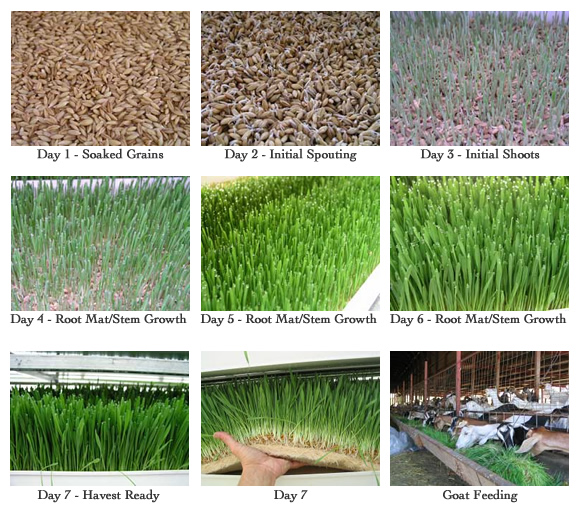I tried to find accurate definitions, this is the best I could come up with:
Sprouting is the practice of germinating seeds to be eaten raw or cooked. Sprouts can be germinated at home or produced industrially. They are a prominent ingredient of the raw food diet and common in Eastern Asian cuisine. Sprouting, like cooking, reduces anti-nutritional compounds in raw legumes.
Sprouting - Wikipedia
In my understanding, a sprout is a seed which has germinated. It can be barely germinated, with little more showing than the growing tip, and a first root, or it can be quite a bit larger. IMO, sprouts are best before any real leaves have appeared. In the case of a grain, you will see the growing sheath from one end, and a single root from the other. If the sheath has broken open, and a grass blade appears, or there are leaves appearing (in the case of a dicotyledon plant) the sprout is now at the "fodder" stage.
In the below pics (barley) Sprouts are shown in pics 2 and 3. Day 4 could also be considered a sprout, as the majority of the blades have not exited the sheaths. Days 5 - 7 are considered fodder. IMO, sprouts are at their best for my poultry at the day 3 - 4 stage. Beyond that, I will still feed them, but consider them to be less than optimal. When sprouting for myself (I like to sprout lentils, brassicas, and alfalfa) I harvest them at the very young sprout stage. A common practice is using sprouted grains (day 2) to make flour and in cooking. Nutrient values are greatly enhanced by sprouting.
Note: sprout stage is variable, and not at all dependent on "what day it is" but more dependent on how much growth there has been. Some grains may take longer to sprout than others, and temperature plays a big role in how quickly they grow.
Even soaking grains will make the nutrients in them more bioavailable. But sprouting, b/c of the enzyme action in the living grain makes a sprout MUCH more nutritious.

Photos from this article: https://www.peakprosperity.com/blog/growing-sprouted-fodder/72618
Sprouting is the practice of germinating seeds to be eaten raw or cooked. Sprouts can be germinated at home or produced industrially. They are a prominent ingredient of the raw food diet and common in Eastern Asian cuisine. Sprouting, like cooking, reduces anti-nutritional compounds in raw legumes.
Sprouting - Wikipedia
In my understanding, a sprout is a seed which has germinated. It can be barely germinated, with little more showing than the growing tip, and a first root, or it can be quite a bit larger. IMO, sprouts are best before any real leaves have appeared. In the case of a grain, you will see the growing sheath from one end, and a single root from the other. If the sheath has broken open, and a grass blade appears, or there are leaves appearing (in the case of a dicotyledon plant) the sprout is now at the "fodder" stage.
In the below pics (barley) Sprouts are shown in pics 2 and 3. Day 4 could also be considered a sprout, as the majority of the blades have not exited the sheaths. Days 5 - 7 are considered fodder. IMO, sprouts are at their best for my poultry at the day 3 - 4 stage. Beyond that, I will still feed them, but consider them to be less than optimal. When sprouting for myself (I like to sprout lentils, brassicas, and alfalfa) I harvest them at the very young sprout stage. A common practice is using sprouted grains (day 2) to make flour and in cooking. Nutrient values are greatly enhanced by sprouting.
Note: sprout stage is variable, and not at all dependent on "what day it is" but more dependent on how much growth there has been. Some grains may take longer to sprout than others, and temperature plays a big role in how quickly they grow.
Even soaking grains will make the nutrients in them more bioavailable. But sprouting, b/c of the enzyme action in the living grain makes a sprout MUCH more nutritious.

Photos from this article: https://www.peakprosperity.com/blog/growing-sprouted-fodder/72618

